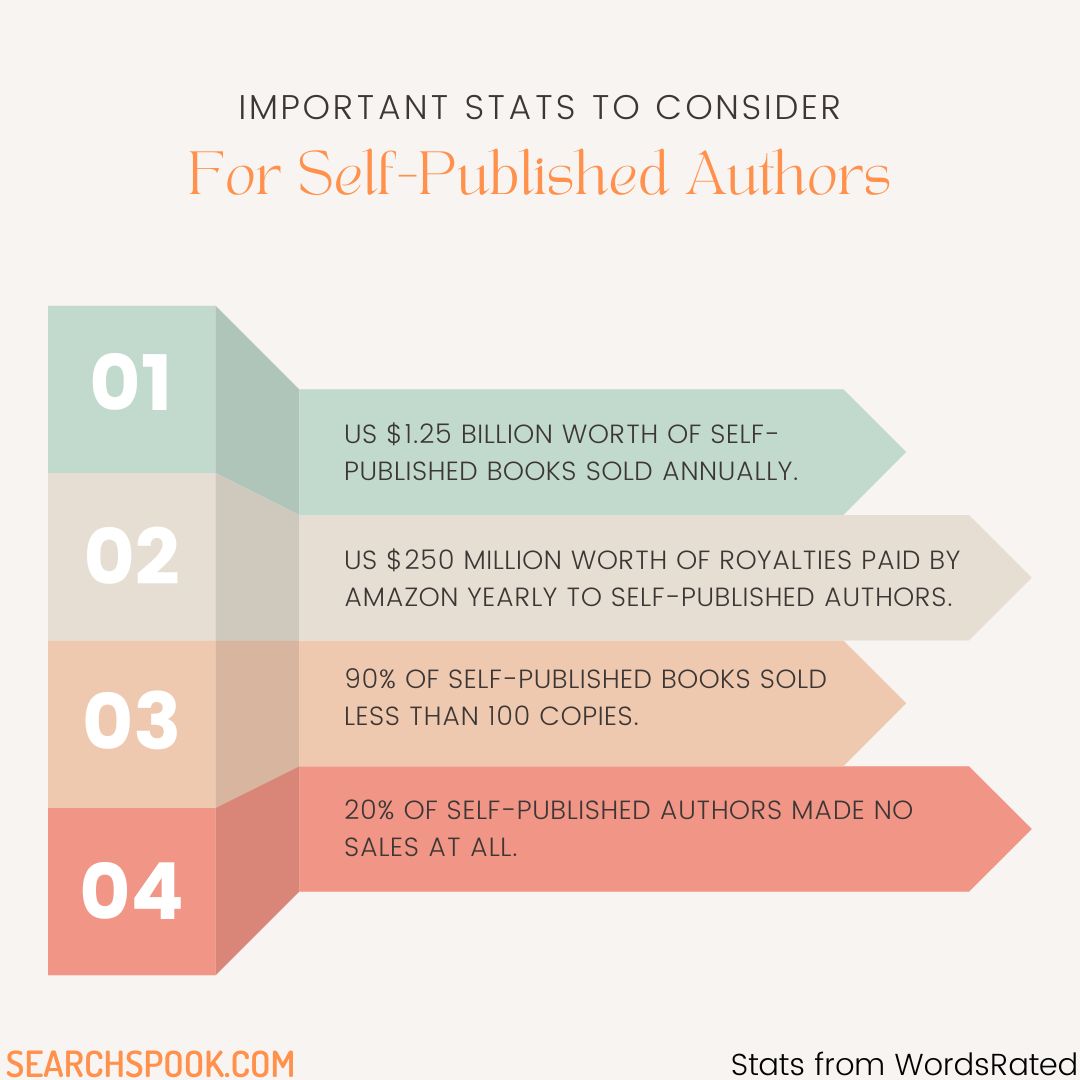Did you know that a few thousand books are listed on Amazon each day? Some estimates put the annual figure at about 4 million new books each year.
Amazon is now close to listing 50 million books on its platform. These numbers are expected to go up exponentially in the coming years considering the huge year on year increase in listings since a decade.
As you can imagine, for a new self-published author, it is a mammoth task to stand out from the crowd and gain any kind of momentum on Amazon.
Typically, the traditional publishers with their deep pockets and huge marketing brigade are able to quickly go up the charts to the bestseller category.
On the other hand, for a self-published author with a limited or zero marketing budget, it becomes almost impossible to sell even a few copies of their books.
No wonder then that the platform has become a graveyard for millions of genuinely well-written books by self-published authors.
Why Amazon is still the best place for self-published authors

It is not all doom and gloom for self-published authors. Consider the following data.
As per WordsRated, a not-for-profit research organization;
1) 300 million books written by self-published authors are sold annually, generating a revenue of US $1.25 billion.
2) Amazon alone pays US $250 million in royalties to self-published authors on an annual basis.
3) However, 20% of self-published authors make no money at all from their book.
4) 90% of self-published books sell less than 100 copies.
What do the above statistics about self-published books tell you? For me, there is something that really sticks out and calls for undivided attention.
If 300 million books are sold with a total revenue of US $1.25 billion and at the same time, 90% of books sold less than 100 copies, it means some self-published authors have sold so many books that it has made them richer beyond their wildest dreams.
Remember, these are just annual figures. Hence, taking an extended period into consideration, some authors are selling millions of copies of their books while others are not even selling a single copy.
Self-Published authors need smart marketing
Marketing is hard. If it was easy, everyone would be super rich and successful.
As you can see with the statistics given above, there are self-published authors who are making way more money than what they could have possibly imagined.
If they can do it, you can too.
What you need is a smart marketing plan. You have already worked quite hard on writing your book. There is no need to make things tougher with complicated book promotion plans.
What you need to do is find a way to stand out from the crowd. Let Amazon’s algorithms and own marketing push put your book in front of your target audience.
The big question is how? How do you stand out when millions of books are being listed each year? How do you compete with those authors who either have strong backing of a publisher or are already established enough to stay on top of the bestsellers list?
The General Recommended Marketing Plan for Self-Published Authors
Before we get into how you can stand out from the colossal crowd, here is the generally recommended marketing plan for self-published authors.
If you are not doing any of these already, you should.
- Get a website and list all your books.
- Start blogging on your website.
- Create an author page on Goodreads and Amazon.
- Create social media accounts on Facebook, Instagram, Twitter and Pinterest. Ensure you are active on each platform posting new content daily.
- Interact with fellow authors or book enthusiasts through Facebook groups.
- Do book giveaways in exchange of honest reviews on various platforms.
- Look for book forums and sites and ask for author feature or book reviews.
- Ask friends and family to purchase your book and leave honest reviews.
- Build a mailing list of interested readers and send out interesting content.
- Do paid advertising on Amazon.
The above is not an exhaustive list but the very least you should be doing.
Of course, this is what every author is probably doing. Therefore, you need to be smart and perhaps redirect your limited budget to something smarter.
How Self-Published Authors can Stand Out on Amazon

So, let’s get to the all-important question, how do self-published authors stand out on Amazon?
Is it really possible to sell a decent number of books while competing against millions of established authors?
The answer is in Amazon Data Analytics and Competitor Analysis. That is what you as an author need to do.
Now, if your heart just sank wondering how on earth can you, with no technical knowledge, conduct comprehensive and accurate data analytics, then please do not worry.
Obviously, no one can do this without the help of tools already out there. I will show you the best Amazon data analytics tool with competitor analysis.
Before we get to the tools and services you need to be using, you need to get a basic idea of how Amazon lets you list a book, its internal algorithms, importance of the ‘right’ keywords and categories for your book and a few other aspects.
Understanding Amazon’s Book Listing and Algorithms
Over the years, Amazon has worked hard to understand the ‘intent’ of their users when they search for any keyword or phrase.
It is the same as what Google does with its search engine queries.
When a user types anything on the Amazon search bar, the internal algorithms based on various factors and past habits of the user, pushes products that they are most likely to purchase.
For authors, when listing a book on the platform, Amazon allows you to add:
- An appropriate title and a sub-title.
- Description of the book.
- Book category.
- Up to seven keywords that match your book content.
Of course, there are other particulars like author name, actual book file in case of Kindle ebooks etc.
However, for our understanding of data analytics, keep the 4 aspects given in the bullet list above in mind.
Most authors would simply list their book as is. So, title would match the actual book title. Description would be the book synopsis and keywords would be related to the genre.
For category, they would choose the most obvious category. For example, if they have written a paranormal romance book, they would list it under paranormal romance.
Unfortunately, by doing this, you are killing your book sales even before you have started your marketing campaign.
Just take the category for example.
This is a super important consideration and cannot be taken lightly. Amazon has hundreds of sub-categories under each heading.
If you simply chose paranormal romance as per our example, you are then directly competing against millions of books. Even if you get a good start and sell lots of copies, you are not exactly going up the charts.
Hence, Amazon’s internal algorithms will not push your book to users as it does not see it as something that is gaining momentum.
Instead, you need to choose a category that comes under paranormal romance, has high sales but at the same time does not have much competition. In this case, even if you sell a few copies, the system sees it as a book fast gaining momentum in its category and starts pushing it to users searching for similar books.
It even starts adding it to their regular mailers sent to potential buyers.
Now let’s take keywords into consideration.
Do not simply add your own keywords that you think matches the book content. You need to use keywords that Amazon’s users are searching for and are ‘intent’ keywords.
After this, these keywords need to be strategically placed in your book description and possibly in the title as well.
The book description area allows you to add a lot of content. So, you can write your synopsis, add reviews and create a lot more content to include all the ‘intent’ keywords in that section.
By doing this, you are directly letting Amazon’s algorithms know that your book is a match for their ‘intent’ search calculations.
The bottom line is that you need to create your book’s listing on Amazon, based on data analytics.
You need to know the most appropriate category for sales, the best intent keywords and then only list your book.
Many authors use data analytics tools to understand the best categories for them and then start writing a book that fits the category well. Whatever, you do, do not use the main categories in your genre as that would lead to hardly any sales for your book.
Now let us come to competitor analysis.
Did you know it was possible to retrieve book sales data of each of your competitors? Would you like to replicate the keywords and book listing data of the bestsellers in your category?
Through Amazon author competitor analysis, you can get precise data on the daily and monthly sales of all authors for each of their books.
Once you see a book doing really well in your category, you can go to that listing and try to understand the keywords they are using, their title, subtitle, description style, specific content used etc. Next you can replicate the major keywords and style of listing in your own book page.
This is quite a useful feature as you can replicate the work of bestselling authors and get the ripple effect of their sales.
When you research on competitors, check who is a self-published author and who is backed by a publishing house.
If you find a self-published author with high sales, that’s your target for replication.
Remember, Amazon displays ‘similar books’ to users who have purchased comparable books such as yours and you want to get into that list to increase your own sales.
Get readymade keyword list for your Amazon Ads campaign
One of the best ways to get a quick boost in Amazon is to run an ad campaign targeting users searching for books similar to yours.
Many authors run an ad campaign, increase sales and then stop the campaign after a few days. With the momentum in sales, your books start appearing in organic searches and in Amazon’s own marketing push through mailers, on-screen recommendations etc.
However, there is no point in running an ad campaign using keywords that do not sell.
You need a list of keywords that users are actually searching for, are not already saturated and have a high probability of sales.
You need profitable keywords with high intent of purchase.
This is again where data analytics tools are extremely useful. Instead of spending hours, weeks or months researching on the best keywords, you can get a complete list in a matter of minutes that have the best chance for conversion.
To Recap, this is what you can and should be doing via Amazon data analytics and competitor analysis tools.
1) Choose the appropriate category in your niche.
Category needs to be a sub-category of your main genre that has high book sales but low competition.
You can choose up to two categories for your books on Amazon.
By doing this, even with a few sales, you can go up the rankings quickly, get picked up by Amazon’s internal algorithms for marketing push and gain momentum all the way to the respective category bestseller list.
You also get access to all of those who have already bought books within those sub-categories through Amazon recommendations.
2) Find the appropriate ‘intent’ keywords.
Remember, it is all about intent. Not only do you need to know which keywords have the highest user searches, but also the ones that lead to more sales.
Let the data analytics tools show you these keywords, choose the most relevant 7 keywords, and include these in your book description.
The most important keyword should be included in your sub-title when listing the book on Amazon. If possible, use it in your main title as well.
3) Competitor analysis to replicate the bestsellers.
Analyze competitors in your niche and get their daily as well as monthly sales volumes.
Ideally visit book listings of successful self-published authors and replicate the keywords or phrases they are using on their page.
This will not only push your own book up the search rankings, it will help you ride the wave of the sales made by the competitor authors.
Your book will start showing up in recommendations on Amazon and on the emailers as the platform tries to push for more sales by recommending similar books.
4) Get the best keywords for Amazon Ad campaigns within minutes.
Give a quick boost to your book sales with the most sought-after keywords on Amazon.
Without knowing the keywords that convert the best, there is no point in a trial-and-error ad campaign on Amazon.
Once you gain some initial sales and assuming you have listed your book in an appropriate sub-category in your genre, you can stop the paid campaign and still continue to get organic sales as Amazon’s algorithms will start pushing your book as recommendations to all users.
Which Amazon Data Analytics and Competitor Analysis tools should you use?
As I had mentioned earlier, you do not need to be a tech expert to conduct data analytics and competitor analysis.
You just need the best tools that do everything for you.
The most highly recommended tool that every self-published author should use is Publisher Rocket.
It can do everything I have mentioned here and do it well. It has an easy-to-use interface and is quite intuitive in getting accurate data.
Another reason it is the go-to tool for authors is that it is a one-time purchase only. So, no recurring monthly fees and can be used for all of your book research and listings.
Apart from Publisher Rocket, there is KD Spy which is focused heavily on author competitor analysis. It can get some seriously valuable data on your competitors selling books on Amazon which can then be used for your own book listings.
There are other tools and services as well that you can find online. My only suggestion would be not to purchase something with a recurring fee. A one-time investment is ideal as you can get a return on it fairly quickly and reuse them for as long as you want.
Final thoughts
Selling books on Amazon is tough for a self-published author. The competition is intense. Most books get lost in the crowd almost instantly after listing.
With millions of books getting listed each year, the only path to success with a limited budget is to stand out with smart tools that let Amazon’s own algorithms go to work for you.
If you do taste success, the rewards are so high that it could turn your every dream into reality.
The most important dream of course, would be to make a living from being an author, write books that you love and on your own terms without the need of a publisher.





